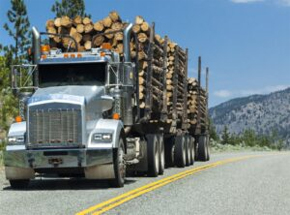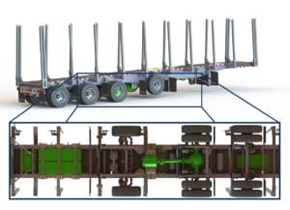With an increased focus and need to reduce Canada’s greenhouse gas (GHG) emissions and the ongoing need to reduce transportation costs — in part as a result of carbon taxes —, identifying and implementing viable options for shifting to zero-emission vehicles (ZEV) and low-emission vehicles (LEV) in the forest industry have been of increasing interest due to their lower fuel use and lower GHG emissions.
As other industries and consumer markets move towards electrification at a fast pace, FPInnovations has been investigating the state of ZEV and LEV technologies as well as their readiness level for forest transportation.
Why electric trucks?
As per Environment and Climate Change Canada, the Canadian transportation sector is responsible for almost a quarter of total GHG emissions in Canada. In forest operations, transportation accounts for approximately 35-45% of their total GHG emissions, so one of the key measures to reduce carbon emissions in the forest sector is through the electrification of forestry transportation.
 Electrification (plug-in hybrid and battery electric) has gained popularity in recent years due to its potential to accelerate Canada’s low carbon future. An increasing number of original equipment manufacturers (OEM) and start-ups have begun offering and are continuing to develop fully electric and hybrid electric solutions to the market.
Electrification (plug-in hybrid and battery electric) has gained popularity in recent years due to its potential to accelerate Canada’s low carbon future. An increasing number of original equipment manufacturers (OEM) and start-ups have begun offering and are continuing to develop fully electric and hybrid electric solutions to the market.
Vehicle electrification has progressed significantly with advanced battery technology, a significant reduction in battery prices, and faster battery charging times. Government incentives and support for fleets to adopt zero emission vehicles — with funds collected through carbon tax programs — are being directed towards financing GHG reduction initiatives such as purchase of clean energy vehicles or the establishment of clean energy infrastructure. In addition, there are various federal and provincial tax reductions and rebates currently being offered.
Forestry transportation: a whole other ball game
Apart from reducing carbon emissions, the electrification of heavy-duty forestry trucks could also provide many additional benefits and opportunities for logging contractors and forestry companies, such as:
- Improved startability and gradeability due to availability of instantaneous torque
- Reduced maintenance costs with fewer moving parts and lack of need for fluid oil
- Extended range and improved fuel efficiency with recovered energy using regenerative braking, especially in foothill and mountainous regions
These are all benefits that could translate into reduced total ownership and operating cost along with reduced energy and maintenance costs, higher tax rebates, and other incentives.
Cherry on top: improved driver comfort due to quieter operation and less strenuous to drive – two factors that would help with driver attraction and retention.
The widespread adoption of electric vehicles in the forest sector still faces many obstacles to overcome including limited range, lack of battery charging infrastructure, as well as high purchase costs (estimated 3x the cost of conventional diesel truck, not accounting for rebates and incentives) and current limited supply of these types of vehicles.
 In addition, the demanding forest conditions such as the rougher terrain, harsh operating conditions, heavier payload, and the lack of access to power along remote hauling routes further lengthens the timeline until electric heavy-duty vehicles are available to the forest sector. For example, current and soon-to-be-available electric heavy-duty trucks have a maximum weight allowance of 36 tonne (80 000lbs) gross vehicle weight (GVW), which includes truck weight and payload, as compared to a 57.5 tonne GVW configuration common in Ontario.
In addition, the demanding forest conditions such as the rougher terrain, harsh operating conditions, heavier payload, and the lack of access to power along remote hauling routes further lengthens the timeline until electric heavy-duty vehicles are available to the forest sector. For example, current and soon-to-be-available electric heavy-duty trucks have a maximum weight allowance of 36 tonne (80 000lbs) gross vehicle weight (GVW), which includes truck weight and payload, as compared to a 57.5 tonne GVW configuration common in Ontario.
What’s next?
Large scale deployment of heavy-duty electric trucks in the sector will take several years as technologies continue to mature and offer a viable option.
Near-term opportunities in forest operations exist with shorter haul distances and close-to-existing infrastructure that can be leveraged to initiate implementation. In the coming months, FPInnovations will be examining the electrification of a fleet with a short duty cycle using a tractor semi-trailer configuration working in a mill-yard.
 FPInnovations is currently also developing two prototype hybrid semi-trailers in forestry – a log hauling quad semi-trailer as well as a biomass hauling tridem semi-trailer – that replace one of the trailer axles with an electrically-driven drive axle. Hybrid electric vehicles promise near-term implementation, modest GHG emissions reductions, and a reasonable price while forest transportation electrification technology matures.
FPInnovations is currently also developing two prototype hybrid semi-trailers in forestry – a log hauling quad semi-trailer as well as a biomass hauling tridem semi-trailer – that replace one of the trailer axles with an electrically-driven drive axle. Hybrid electric vehicles promise near-term implementation, modest GHG emissions reductions, and a reasonable price while forest transportation electrification technology matures.
Zero-emission and low-emission vehicles have a promising future in forest transportation to help decarbonize the forest sector while improving transportation efficiency. Many in the forest sector are excited about heavy-duty electric truck technologies but many challenges need to be addressed before electrification becomes viable.
An intermediate step toward fully electric trucks is the use of hybrid technologies that meet the power and range requirements for forest operations. Exciting developments with ZEV and LEV vehicle technologies can be expected in the coming years.
For more information, please contact
Source: FPInnovations













